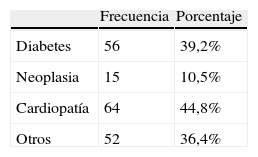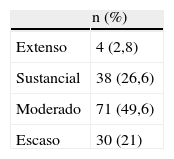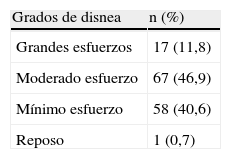Conocer el perfil sociodemográfico y clínico del paciente con enfermedad pulmonar obstructiva crónica (EPOC): características, estado de salud, situación de enfermedad y recursos sociales.
MétodoEstudio descriptivo, longitudinal y prospectivo, en los Hospitales Morales Meseguer y Reina Sofía de Murcia, entre junio de 2007 y abril de 2008. El criterio de inclusión fue ingreso por EPOC, y se excluyó a pacientes con deterioro cognitivo, ingreso superior a 30 días o inferior a 2 e institucionalizados. Se recogieron variables sociodemográficas, estado de salud y social (escalas validadas) mediante historia clínica y entrevista durante la estancia y al alta. El análisis estadístico descriptivo se realizó mediante SPSS v.15.
ResultadosSe estudió a 143 pacientes; el 90,2% eran varones; la media de edad, 72,76±8,04 años; el 95,1% estaba en situación laboral inactiva y tenía una puntuación media en la escala de problemas sociales de 8,08±2,1. El 71,3% es frágil, el 44,8% padece cardiopatía como principal factor de comorbilidad, y el impacto de la enfermedad en la calidad de vida fue de 55,1±19,01. El nivel de conocimientos sobre el régimen terapéutico fue de 3,13±0,7. El 72% son independientes para actividades básicas de la vida diaria (ABVD) tras el alta hospitalaria.
ConclusionesLa mayor parte de la población que padece EPOC son varones de edad avanzada, jubilados sin problemas sociales, con un elevado porcentaje de comorbilidad, una alteración intermedia en la calidad de vida y un nivel moderado de conocimientos sobre el régimen terapéutico y son independientes para ABVD, pero frágiles.
To find out the socio-demographic and clinical profile of the patient with Chronic Obstructive Pulmonary Disease (COPD): characteristics, state of health, situation of disease and social resources.
MethodA descriptive, longitudinal and prospective study, in the Morales Meseguer and Reina Sofía Hospitals in Murcia (Spain), was performed between June 2007 and April 2008. The inclusion criteria was hospital admission due to COPD and patients with cognitive deterioration, a hospital stay >30 days or<2 days, or were institutionalised, were excluded. Socio-demographic, state of health and social variables were collected using the patient's clinical history and an interview during hospital stay and at discharge. The descriptive statistical analysis was carried out using SPSS v.15.
ResultsA total of 143 patients were studied, of which 90.2% were males who had a mean age of 72.76±8.04 years, 95.1% were in an inactive work situation and had a mean score on the social problem scale of 8.08±2.1. Most were in a fragile state (71.3%), approximately half (44.8%) suffered heart disease as the main co-morbidity factor, and the impact of the disease on quality of life was 55.1±19.01. The level of knowledge on the therapeutic regime was 3.13±0.7. A total of 72% were independent for carrying out Basic Activities of Daily Living (BADL) after hospital discharge.
ConclusionsMost of the population that suffers from COPD were elderly males, who were retired without social problems, with a high percentage of co-morbidity, an intermediate alteration in their quality of life, having a moderate level of knowledge about the therapeutic regime and were independent for BADL, but fragile.
Artículo
Comprando el artículo el PDF del mismo podrá ser descargado
Precio 19,34 €
Comprar ahora












